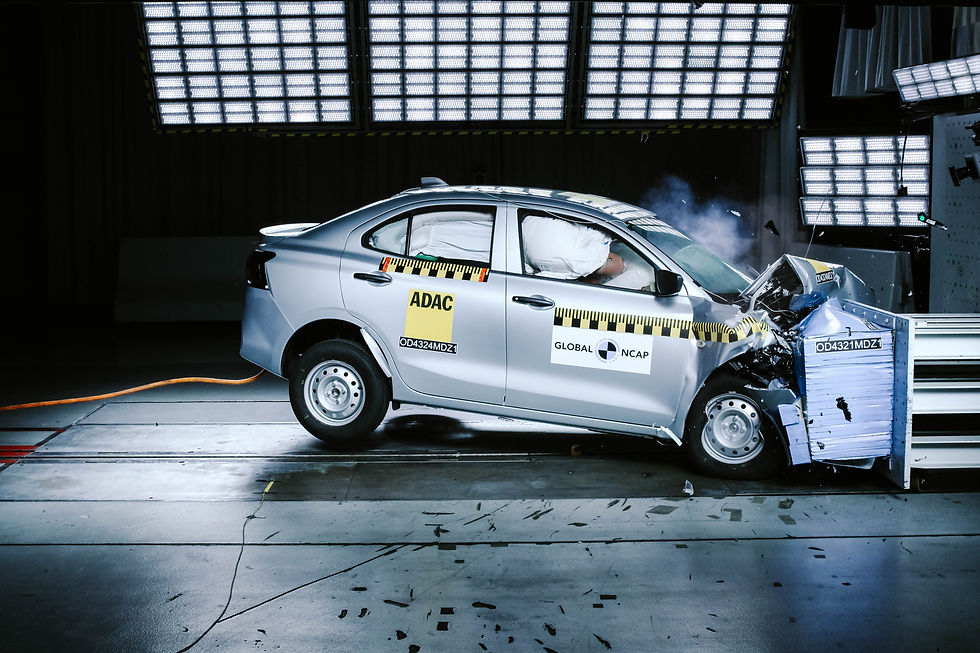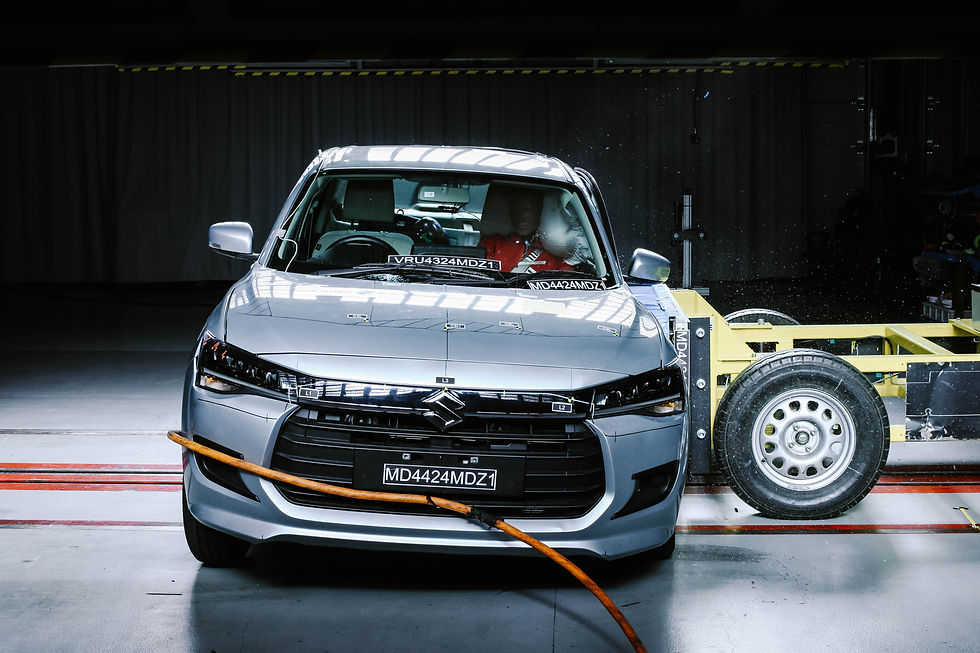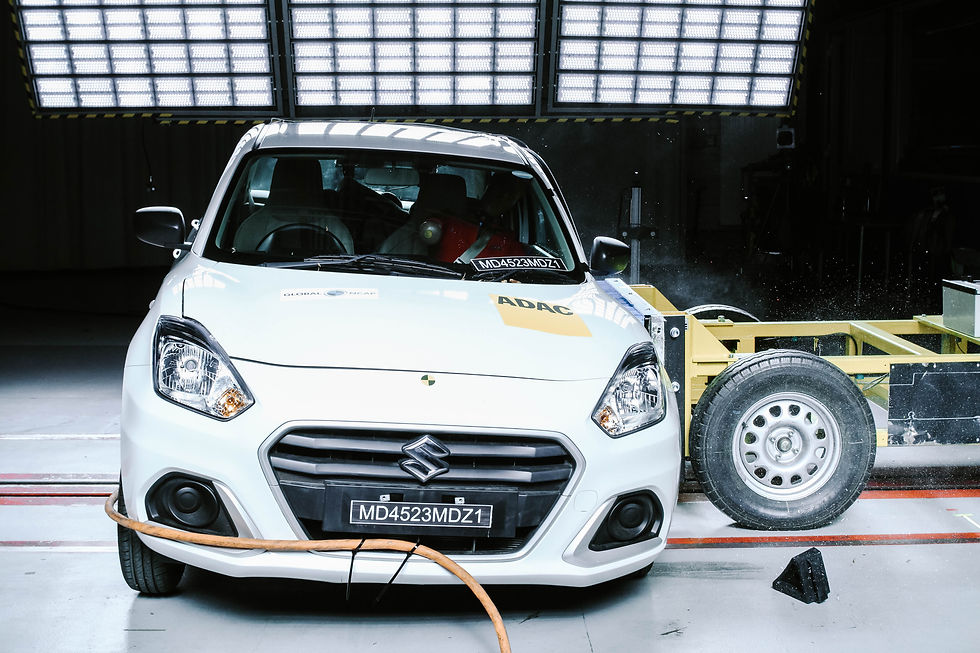Global NCAP: A Tale of Two Dzires
- Gobar NCRAP
- Nov 8, 2024
- 4 min read
Updated: Nov 14, 2024

The 4th-generation Maruti Suzuki Dzire has been awarded a 5-star rating for adult occupant protection and four stars for child occupant protection in crash tests by consumer tester Global NCAP. The outgoing 3rd-generation Dzire, hereafter known as the "Tour S" fleet version, was also tested last year and has been rated two stars for adult and child occupant protection.
Maruti Suzuki Dzire (4th-generation)

Adult protection: 5 stars
Frontal offset test (64 km/h)
Dummy readings showed low risk of skull fracture and airbag contact of the head was stable
But there was moderate risk of rib fracture owing to compression of the driver's chest. The Dzire has a "dual load path" design, which means it is designed to use only the roof and floor to transfer forces elastically through the passenger cell. Neither showed permanent deformation, so the passenger compartment was classified structurally stable
Suzuki provided GNCAP with evidence demonstrating that the knees of occupants of different sizes and seating positions would be protected similarly — the new Dzire has a lap pretensioner for the driver's seatbelt (i.e. an additional pretensioner at the seatbelt anchor that tightens even the lap portion of the seatbelt in a crash).
The pedals released from their mountings and the floor pan showed insignificant deformation
Side impact (car) (50 km/h)
Low risk of serious injury (of evaluated type) for skull, ribs, abdomen and pubis
Side impact (pole) (29 km/h)
Low risk of serious injury for skull, abdomen and pubis; moderate risk of serious rib fracture
The Dzire also has standard-fit ESC, curtain airbags and rear seatbelt reminders.
Child occupants: 4 stars
The Dzire's rear outboard seating positions are i-Size and all positions have an automatic three-point seatbelt. The Dzire could safely accomodate many child seats on the market. Crash test results are:
3 year-old — Britax Trifix forward facing with ISOFIX and top tether — good head and chest protection, weak chest protection
18 month-old — Britax BabySafe rearward-facing on Flexbase 5z with ISOFIX and support leg — good protection all-round
Maruti Suzuki Dzire (3rd-generation) / Maruti Suzuki Tour S

Adult protection: 2 stars
Frontal offset test (64 km/h)
Dummy readings showed low risk of skull fracture and airbag contact of the head was stable
There was limited risk of rib fracture owing to compression of the driver's chest. Inspection of the vehicle's load paths after the test revealed at least one was permanently deformed, so the passenger cell was deemed to have become structurally unstable
Although dummy readings indicated good knee protection, dangerous structures behind the dashboard could compromise protection of occupants of different statures or positions
The floor pan ruptured and the pedals were driven back excessively
Side impact (car) (50 km/h)
Low or limited risk of serious injury (of evaluated type) for skull, abdomen and pubis, high risk of serious rib fracture
The Dzire also has standard-fit ESC and rear seatbelt reminders, but the rating was limited to 2 stars as it does not offer curtain airbags, even as an option.
Child occupants: 2 stars
The old Dzire's rear outboard seating positions are NOT i-Size (unlike the Swift it was based on) and the centre position does not have an automatic three-point seatbelt. The Dzire could safely accomodate some child seats on the market. Crash test results are:
3 year-old — Joie Spin 360 rearward-facing with ISOFIX and top tether — good protection in frontal impact, head contact in side impact
18 month-old — Britax BabySafe rearward-facing on Flexbase 5z with ISOFIX and support leg — good protection all-round
About Global NCAP #SaferCarsForIndia crash tests
Global NCAP tests cars for passive safety in five scenarios:
a moderately off-centre frontal crash into a deformable barrier representing another similar car
a side impact with a moving barrier representing a small car striking the driver's door
optionally*, a side pole test where the car is propelled laterally on a sled with the driver's head targeted at a rigid pole representing a tree or roadside object
optionally*, pedestrian head protection tests with instrumented headforms representing adult (4.5kg) and child (3.5kg) heads striking various locations on the hood and the base of the windscreen
optionally*, pedestrian lower leg protection tests at various locations on the bumper, with an older, less realistic "flexPLI" impactor that does not mimic pelvis weight
*at the vehicle manufacturer’s request and expense
Additionally, the following active safety technologies are evaluated:
front and rear seatbelt reminders for extra credit
electronic stability control in a robotised "sine-dwell" emergency steering manouevre
In all tests, the front seat(s) carry belted dummies representing the median European adult male. In the front and side impact tests, the rear seats carry dummies representing 1.5 and 3 year-old children in child seats selected and installed as directed by the car manufacturer.
The dummy readings are translated to scores based on corresponding probability of serious/severe/critical injury to the part in empirical testing. Body parts are then also penalised if there are signs that the robustness of the dummy response has been compromised. Finally, additional points for safety features are added and qualifying extra requirements considered to generate a star rating.
Factors like speed, occupant stature and structural compatibility with crash partners can greatly affect the real-world reproducibility of test results. Other factors like geometric homogeneity of the test barriers or flaws in dummy biofidelity due to ever-expanding anthropometry research may also result in cars being over-optimised to test scenarios, often unknowingly as car manufacturers are given test requirements as a "black box" and need not be concerned with research or details about development of the tests. The results may also not be assumed to apply when child seats different from the ones used in the test are used.
Note: Gobar NCRAP will only evaluate the Dzire when it is clear which variants have a TPMS







Comments